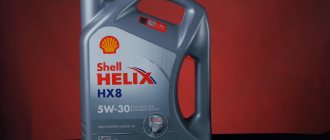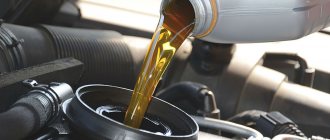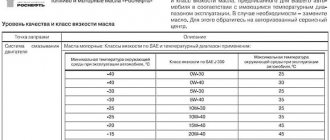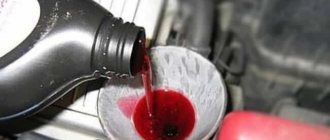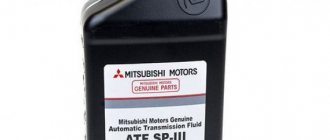Inexperienced motorists are often faced with the concept of motor oil labeling. This definition was created to accurately delimit the scope of application of hydraulic fluids. For example, the ACEA A5/B5 marking is a modern standard, suitable exclusively for new cars. There is also a series of API, SAE and other standards that explain the level of compliance of a liquid with certain operating conditions. Additionally, there are markings on the date of manufacture of the products, indicating the shelf life.
The last straw is that some automakers produce their own fluids under the same brand. These lubricants are designed for specific motors. For example, Toyota does not recommend lubricants other than its own developments.
It is necessary to consistently understand what each group of standards means and how to choose the necessary markings.
What is the role of oil in a car?
Lubricants perform a number of important functions in a car.
- Lubrication and cooling of the power plant.
- The liquid prevents dry friction of moving parts, eliminating the formation of chips and scuffs on the surface.
- Cleaning the engine and transmission. Modern oils contain a number of alkalis that neutralize sulfuric acid and remove sludge deposits from the mains.
- Fuel economy - increased sliding of units minimizes energy consumption to overcome resistance.
Existing classifications
In 2021, there are more than 10 generally accepted classifications of motor oils. Liquids are divided according to the design of the engines being serviced, quality standards, and the base used.
Classifications of world brands
Each auto chemical manufacturer must undergo tests of certain specifications. Before releasing a lubricant onto the market, specification marks must be obtained:
- API;
- ACEA;
- ILSAC;
- JASO;
- GOST
Depending on the sales region and the equipment to be serviced, the manufacturer may receive one or more approvals. For example, if there is an API SN/CF marking, the lubricant may not have the ACEA A3/B4 inscription, which is suitable by analogy. Maybe this is not necessary or the manufacturer did not issue approval.
Classification of motor oils by engine type
Modern units differ in design and performance characteristics. A wide range of auxiliary equipment settings are used here. Lubricants are also divided into several categories:
- gasoline;
- diesel;
- universal;
- for turbocharged internal combustion engines or naturally aspirated engines;
- suitable for power plants equipped with exhaust cleaning systems.
Classification of motor oils by chemical composition
Depending on the base used, there are 3 types of liquids.
- Mineral. Here they use natural bases obtained by distillation of sulfurous petroleum.
- Semi-synthetic. Formulas are obtained by mixing mineral and artificial components, or hydrocracking processing. The latter is often called synthetic, but technically it is not.
- Synthetics. Completely artificial lubricants with enhanced performance characteristics. The mixtures are obtained in laboratory conditions, where molecules of natural gas or rapeseed oil are broken down. Additions of polyalphaolefins and esters are also possible here.
API classification
API is an abbreviation for the American Petroleum Institute; according to the developed classification, oils are divided into 2 types:
- S (Service) - this marking indicates that the oil is suitable for gasoline power plants of passenger cars, light-duty vehicles, and minibuses;
- C (Commercial) – this category includes heavy equipment with diesel engines.
For passenger cars with diesel power plants, universal oils designated S/C are suitable.
The letter next to it indicates the characteristics of the mixture. The closer it is to the end of the alphabet, the better properties the oil demonstrates.
- Markings SC, SD, SE, SF, SG, SH are considered obsolete; such oils are intended for engines built before 2001. Products are still being produced as old cars are still common on the roads;
- SJ – for engines from 2001 and older;
- SL – for engines manufactured since 2004;
- SM - standard introduced in 2004, such oils are characterized by increased resistance to oxidation, increased protection against wear and deposits, and are operated at different temperatures;
- EC is an abbreviation for Energy Conserving oils for gasoline engines.
If there is a number after the letter, it indicates the type of diesel engine: 2 - two-stroke, 4 - four-stroke.
Whether the oil meets the stated specification is checked by the API commission.
Decoding engine oil (useful information)
There are generally accepted tolerances and standards found on every canister of motor oil. There are simple ways to understand what quality a lubricant is.
Deciphering automobile oils in the light of world standards
For example, you can take the API specification. There are two common rules here:
- S;
- WITH.
The first is created for gasoline lubricants, the second for diesel engines. Often they can be found at the same time, and SN/CF will be higher in quality than the same SL/CG. The point is in the second letter of the index. The additional symbol indicates the quality of the lubricant and, depending on the class, is taken from the standard alphabet.
In the second popular ACEA specification, markings are also applied according to a similar principle. Of the contradictions here, the quality of the mixture is determined by applying a number, not a letter. The higher the number, the more modern standards the mixture meets.
Labeling of motor oils in Russia
Domestic GOST separates lubricants according to its principle. Here, each letter or number of the code indicates a specific parameter. For example, you can take lubricant M 63/10B where:
- M – motor oil;
- 63 – low-temperature viscosity index;
- 10 high temperature yield strength;
- B – suitable for gasoline engines with medium boost.
How to distinguish oil by labeling based on its chemical composition
The performance characteristics of a motor oil in 90% of cases depend on the quality of the lubricant base.
This indicator directly affects the service life and quality of engine protection. All modern lubricants are divided into three categories according to the properties of the base mixture. Nothing depends on the brand name - most companies produce a wide range of products with formulas of different compositions.
This variety allows the motorist to achieve the necessary results without spending additional money. For example, mineral water with indexes 10W40 or 15W40 is optimally suited for old internal combustion engines, mainly used in classic engines. At the same time, high-tech synthetics marked 0w20, 0W30 are harmoniously combined with modern engines that require the use of easily fluid mixtures.
Synthetic oil marking
In 2021, such lubricants are gaining popularity among automakers. Synthetics are extremely stable during temperature changes. It stands out for its extreme protective properties. The base production technology is marked on the canister as Fully Synthetic, which indicates the procedure for artificially obtaining base lubricants. The category contains 2 subgroups - PAO and ester oils.
- PAOs are considered the most common. This type of base is often used by manufacturers such as VW or Castrol. Typical viscosity for the 5W30 formula and approximate varieties.
- The second group is mixtures formed by adding ester alcohols (nothing in common with drinking alcohols). Such substances have one important advantage - heavy molecules are positively charged, which allows them to be attracted to the metal.
Regardless of the type, synthetic lubricants show increased reliability and durability.
Marking of semi-synthetic oil
Semi-synthetics are labeled as Semi-Synthetic. Having seen such a designation on the canister, we can safely say that this is exactly the product in front of the buyer.
A prominent representative of a semi-artificial type automobile oil is Nissan 10W40. However, today such mixtures are most often used to service the gearbox transmission unit, drives and gear mechanisms.
When choosing semi-synthetic for a car, the user makes a compromise.
Lubricants stand out for their average performance in all characteristics, including price. However, the disadvantage of this solution is the lack of necessary protective properties under critical loads.
The technology of hydrocracking or HC stands out separately - such markings can also be found on packages of motor oils. This variety is difficult to categorize. Most brands classify it as synthetic, but this is partially not true. Hydrocracking technology brings the properties of semi-synthetics closer to those of a 100% artificial liquid, but in essence the base is not such.
Mineral motor oil markings
Mineral water or Mineral OIL is rarely used in 2021. These formulas are aimed at servicing power units of classic cars. The characteristics of the product do not allow the new type to be poured into engines due to a lack of lubricating and protective properties - they quickly oxidize, require replacement when boiling, and leave a large amount of sludge deposits.
The advantage of the product is its minimal cost.
Dependence of oil viscosity on temperature
Oddly enough, not only the possibility of using oil in a certain temperature range, but also its service life, and accordingly, the frequency of replacement, depends on the viscosity. What is this connected with? Read on.
The required viscosity of the oil is provided by viscosity additives. They are long synthetic chains that have different surface tension on both sides. The lower the temperature, the more they curl into a “ball” and provide the necessary fluidity of the oil at sub-zero temperatures.
In descriptions of motor oils they often write: “Provides even easier engine starting at low temperatures.” This is the very ability of viscous additives to curl into a “ball”.
How does the viscosity of oil change with increasing temperature? In this case, the “balls” of viscosity additives, on the contrary, unfold into chains and, randomly oriented throughout the entire volume of the oil, provide high viscosity at high temperatures.
The length of the chains of viscosity additives depends on the viscosity of the oil: the greater the range between the winter and summer parameters, the longer the chain. Moreover, if you compare the length of the oil chain of 5w-30 and 5w-40, it will be several times longer (not by percentages, but by several times).
The longer the chain, the fewer folds and unfolds it is designed for. After a certain number of repetitions, these chains begin to break down, the oil loses its viscosity and requires replacement. It is precisely the length of this chain that mainly determines the oil change interval.
Of course, other additive packages also have a great influence on the frequency of oil changes. But we will talk about this another time, and now we will not consider it.
Remember the main thing : the greater the range between winter and summer oil viscosity parameters, the shorter the oil change interval. And vice versa.
Let's give one illustrative example. Until recently, in some dealerships, during warranty service, cars were filled with 5w-50 oil for 15,000 km, citing the fact that this is a cool modern oil created for sports modes.
Yes, this is a really cool modern oil, and it was created specifically for sports modes. But it is not designed for 15,000 km. It needs to be changed after five, well, maximum - after six thousand kilometers, because its viscous chain is long, and it will begin to break down just after these 5-6 thousand km. Keep this in mind.
Just in case, we provide a link to our instructions for changing engine oil.
Oil viscosity marking
On imported lubricants, SAE specification markings are used to indicate viscosity.
The category divides motor oils into 3 groups.
- Winter.
- Summer.
- All-season.
The first variety is indicated by a code consisting of two parts, where the first digit indicates the degree of thickness, and the letter W indicates the possibility of use in winter. The next variety is marked only with a number from 20 to 50 and indicates that it is permissible to use only in the summer.
The last, most interesting option is all-season. Here is a more complex option, where winter and summer indices are combined. For example, you can take the common 5W40 oil. It can be used all year round under wide temperature changes.
The vehicle manufacturer's requirements are set out in the operating instructions (service book).
90% of user manuals state the following requirements:
- Certification level according to API, ACEA, ILSAC, JASO or GOST - there may be one or more standards at the same time.
- Required viscosity according to SAE.
- Recommended service interval.
Climatic conditions of vehicle operation.
In most machines, the engine does not require highly specialized lubrication. Typically, the selection of fluid viscosity is carried out based on the climatic zone of operation. For northern regions, an easily flowing liquid with minimal viscosity is used. In the south there are thick mixtures.
Service life and current condition of the engine.
Both parameters are dependent. If the engine is “dead,” the lubricant is changed 2-3 times more often than if the engine is not in good condition. Due to increased wear of the power plant, the mixture becomes intensively contaminated and consumes active additives, which leads to its premature destruction.
Fuel economy or racing driving style
The selection of lubricant also depends on driving style. During aggressive operation, the engine is subjected to increased loads, which forces the use of thicker lubricants with a higher content of protective additives.
If the driver wants increased fuel economy, a low-viscosity lubricant is poured in, which is not designed to work under overloads and high temperatures.
Popular designations: decoding of 5w30 and 5w40 oils
This classification was adopted by the aforementioned Society of Engineers (SAE) in 1911, when the relative diversity of engines forced oil manufacturers to expand their range.
In addition, by this time, cars began to be used in different climatic zones: it became necessary to classify their applicability depending on the ambient temperature.
It was the viscosity of the oil, or rather the preservation of this parameter in a certain temperature range, that formed the basis of the standard. The SAE classifier received code J300, and included the following temperature thresholds:
- 6 classes for use in winter conditions (in the classical sense for mid-latitudes): 0W, 5W, 10W, 15W, 20W, 25W;
- 5 classes for use in summer conditions: 20, 30, 40, 50, 60.
Since operating cars in tropical climates is not relevant for domestic consumers, let’s consider the so-called all-season oils. They can be poured into a car without being tied to a specific time of year.
At the same time, the designation of temperature compatibility can shift in the desired direction: for regions with a predominance of winter or summer periods.
Narrowly focused standards are typical only for a few regions: the far north, or hot desert areas with constant above-zero temperatures.
note
The Latin letter “W” means Winter, that is, winter. Its presence in the standard means all-season use. That is, the interpretation of 5W 40 prescribes the use of oil not only in winter, but also in summer.
Numerical designations relate the lubricant to temperature conditions, but do not indicate a specific value in degrees. The number to the left of the letter “W” characterizes the winter temperature range, and to the right – the summer one. The connection to temperatures is shown in the illustration, in the form of a diagram.
Two characteristics are especially important for engine operation:
- Pumpability temperature (minimum and maximum). The numbers mean that within the specified range, the oil is guaranteed to pass through the oil pipeline channels, not harden, and will not flow down.
- The minimum temperature at which the starter is able to crank the crankshaft to start the engine. Low temperatures increase the viscosity of the oil so much that it tightly grips the rotating elements.
A good example in the illustration:
In short, for example, the 5w40 oil marking means that the oil is thicker than 5w30 and, therefore, better protects the engine in hot climates.
What does SAE mean in oil labeling?
The international classification SAE divides motor oils according to viscosity and temperature of use. The standard SAE J300 table has more than 15 different categories, each with minimum tolerance thresholds. The main group of motor lubricants is represented by the following mixtures:
- 0W30;
- 0W20;
- 0W40;
- 5W20;
- 5W30;
- 5W40;
- 10W30;
- 15W40.
For transmission substances, the most common tolerances are as follows:
- 75W90;
- 75W80;
- 80W90;
- 85W95.
Using these tolerances, you can determine in what weather the mixture can be operated without harming the internal combustion engine or transmission.
In the marking, the first number indicates the threshold for loss of oil pumpability through the line, the second indicates the maximum temperature threshold at which the required thickness of the protective film is maintained.
For example, viscosity SAE 5W40 indicates that the liquid can be used at temperatures ranging from -35 to +40 degrees Celsius.
In 2021, three types of motor oils are generally accepted; the most convenient way to determine the viscosity is in the table.
Summer oil labeling
Summer lubricants should not be used at subzero ambient temperatures. To distinguish it from other categories, specific SAE markings are applied to the canisters. A characteristic difference is the absence of the letter “W” in the designation. For example, for summer operation up to +40 degrees Celsius, it is important to fill in SAE40/50 type mixtures.
It should also be noted that universal lubricants such as Lukoil Lux, Shell Helix or Total Quartz are not summer, despite the permissibility of their use.
A striking example of summer mixtures is MOBIL Delvac 1330.
Winter engine oil marking
Winter lubricants differ from other variations by a double index and the presence of the letter “W” after the number. The following codes will be typical for such products:
- 0W;
- 5W;
- 10W;
- 20W;
- 25W.
The marking is deciphered as follows:
- “0 or another number” is the minimum temperature (°C) at which the oil retains the necessary fluidity for the normal start of the power plant - in this case -50°C.
- “W” - this letter indicates that the mixture can be poured at subzero temperatures.
Vivid examples of purely winter liquids are:
- Mannol;
- Vipoil;
- Pemco.
Such popular companies as Mobile or Shell are not at all involved in the production of highly specialized formulas, directing all their efforts to the production of universal liquids.
The Shell brand was one of the first to completely abandon the production of winter oils, and today acts as their ardent opponent.
All-season engine oil: markings and decoding
All-season lubricants are widely available on the market due to their universal application. These mixtures have indexes on the canister similar to these:
- 5W30;
- 5W40;
- 10W40;
- 0W20;
- 0W30.
The manufacturer's instructions are deciphered as follows.
- “5” is the threshold for loss of fluidity of engine oil.
- “W” - fluid compatibility for use in winter.
- “40” is the threshold for loss of the required viscosity to retain a strong protective film.
As an example of a classic universal motor oil, the following products can be cited:
- LUKOIL Genesis Armortech 5W-30 A5/B5;
- Oil M-8V (Avtol);
- Lukoil Avangard Ultra 5W-40;
GOST classification
At the beginning of the product code there is a letter M - it indicates that the oil is motor oil. Index 1 indicates oil for gasoline engines, 2 for diesel engines. The following number is assigned to the viscosity grade:
- Fractional codes, for example 63/14, mean that the oil is all-season;
- Markings 10, 12, 14, 20, 16, 24 are summer oil;
- 33, 6, 63, 43, 53 – winter oil.
Oil marked 8 is also all-season. The letter “Z” indicates that the mixture contains a thickening additive and is universal.
The letter index designates the engine group for which the use of engine oil is permitted:
- A – for diesel and gasoline non-boosted engines;
- B – for low-powered power plants;
- B – for medium-force;
- G – for highly forced ones;
- D – for highly accelerated power plants that are used in adverse conditions;
- D – for highly accelerated engines that are used in extreme conditions.
For example, the marking M-6з/10В means that the oil is universal for medium-boost engines, all-season.
Engine oil marking according to API
On the packaging of modern brands such as ZIC or Castrol, you can find the API SM/CF coding and its analogues in different designs.
This index is a requirement of the American Petroleum Institute, which is responsible for the compliance of the mixture with the operating conditions of the internal combustion engine. The main division of the specification is into 2 subgroups.
Oil marking for diesel engines
As of 2021, these standards are relevant.
- CF-4 is a 1990 standard, relevant for engines with and without turbocharging.
- CG-4 - relevant for turbocharged internal combustion engines with direct fuel injection produced after 1995.
- CH-4 is a stricter standard that allows the oil to be used on diesel units using fuel with a sulfur admixture of up to 0.5% inclusive.
- CI-4 is the next generation of the standard, characterizing mixtures intended for tractors, trucks and cars equipped with a turbocharger and direct fuel injection.
- CG-4 – adds compatibility with particulate filters to the previous requirements.
Marking of oils for gasoline engines
For gasoline structures, the use of the following API markings is relevant:
- SL - introduced in 2001 as a replacement for the obsolete ones. Allows use in engines equipped with a turbine and direct injection.
- SM - complements the previous version and is presented as energy saving.
- SN is the newest version of the specification, introduced in 2010. In addition to the earlier requirements, the oils are compatible with bioethanol.
SF Admission – status as of 2021 is considered obsolete.
Remarkable! Many modern brands like Elf, Motul, Liqui Molly produce lubricants with a double specification index. Such products can be poured into the car, regardless of the type of fuel used.
API motor oil markings
In the API classification, the main indicators are: engine type, engine operating mode, oil performance properties, conditions of use and year of manufacture. The standard provides for the division of oils into two categories:
- Category “S” – shows those intended for gasoline engines;
- Category “C” – indicates its intended use for diesel vehicles.
How to decipher API markings?
As we have already found out, the API designation can begin with the letter S or C, which will indicate the type of engine into which it can be filled, and another letter designating the oil class, indicating the level of performance properties.
According to this classification, the decoding of motor oil markings is carried out as follows:
- the abbreviation EC , which is located immediately after API, denotes energy-saving oils ;
- Roman numerals after this abbreviation indicate the level of fuel economy ;
- the letter S (Service) indicates the use of oil for gasoline engines ;
- the letter C (Commercial) denotes oils for diesel engines ;
- after one of these letters there is a level of performance properties, indicated by letters from A (the lowest level) to N and further (the higher the alphabetical order of the second letter in the designation, the higher the oil class);
- universal oil has the letters of both categories separated by an oblique line (for example: API SL/CF);
- API markings for diesel engines are divided into two-stroke (number 2 at the end) and 4-stroke (number 4).
Currently, category “S” consists of 12 classes of motor oils, some of which are already outdated, so we will list only the most current ones:
| Year of introduction | 1980 | 1989 | 1994 | 1997 | 2001 | 2004 | 2010 |
| API oils for gasoline engines | SF | S.G. | SH | S.J. | SL | S.M. | SN |
Category “C” currently consists of 14 classes, half of which are also not used and now you can find the following marking:
| Year of implementation | 1983 | 1990 | 1994 | 1998 | 2004 | 2010 |
| API oils for diesel engines | C.E. | CF-4 | CF, CF-2, CG-4 | CH-4 | CI-4 | CJ-4 |
Those motor oils that have passed the API/SAE test and meet the requirements of current quality categories are indicated on the labels with a round graphic symbol . At the top there is an inscription - “API” (API Service), in the middle there is a viscosity grade according to SAE, as well as a possible degree of energy saving.
When using oil according to “its own” specification, wear and the risk of engine breakdown are reduced, oil waste and fuel consumption are reduced, noise is reduced, engine performance is improved (especially at low temperatures), and the service life of the catalyst and exhaust cleaning system is increased.
ACEA oil marking - what is it?
The abbreviation ACEA stands for Association of European Automobile Manufacturers. Unlike API, the organization regulates motor oils according to their applicability to a specific internal combustion engine design. For example, SG/CD encryption has nothing to do with this “office”. The specification itself contains letters and a number after them.
- A - gasoline.
- B – diesel up to 2.5 liters.
- C is a universal product compatible with exhaust catalyst systems.
- E – cargo units.
It is better to give the decoding in the form of a table.
| Code | Decoding |
| A1/B1 | Low-viscosity mixtures, used only with the permission of the manufacturer. |
| A3/B3 | Lubricants suitable for highly accelerated internal combustion engines with indirect fuel injection. |
| A3/B4 | Fully comply with the same standard, adjusted for the presence of direct injection. |
| A5/B5 | Low-viscosity substances used in the most modern units. |
| C1 | Easy-flowing machine oil formulas compatible with neutralizers. They are distinguished by their energy-saving properties and minimal content of toxic elements. |
| C2 | Repeats standard C1 with the difference in the presence of a toxic component. |
| C3 | Conventional car oils, compatible with particulate filters, without any special characteristics. |
Note! As an example of a double norm, you can take the Castrol Magnatek Stop-Start A3/B4 product.
Decoding the characteristics of motor oils
There are 4 international markings: SAE, API, ACEA and ILSAC. In Russia, liquids are labeled according to the requirements of GOST 17479.1-2015. Let's start with him.
Classification of oils according to GOST
The domestic classification divides technical fluids into groups according to:
- Operational properties.
- Viscosity
- Purpose.
oil classification table according to GOST
The decoding of motor oil includes “M” (means for motor), a number (viscosity class) and a letter (belonging to a group of properties).
SAE oil classification
Is an international standard. The first edition was published in 1911, more than 100 years ago.
SAE oil classification table
In deciphering this generally accepted standard, the main indicator is the dependence of viscosity on the state of the environment. This is the classification of motor oils according to SAE. In the marking, the number before “W” specifies the permissible “minus” that the oil lubricant can withstand. The second number shows the maximum high temperature load.
Interpretation of engine oil "5w30"
The letter “W” means the product is used in cold weather (from the word winter). The number "5" stands for low temperature viscosity and indicates the low temperature limit. In this case - 30°C (subtract 5 from the maximum value according to the standard, -35°C) The number “30” shows high-temperature viscosity. It indicates at what positive temperature this oil can be used. In this case, up to +25°C (subtract the number 5 from 30).
Interpretation of engine oil "5w40"
API classification of oils
The American Petroleum Institute divides liquids by engine type: “S” (gasoline) and “C” (diesel). It was created in 1969 and is based on the production date of the car.
The API marking of engine oil contains 2 letters: SH, SF, CH. The second indicates performance. The further it is in the alphabet, the higher the property of the product. Double marking type “SF/CH” indicates that the lubricant is suitable for all engines.
API oil classification table
Important! The category “For gasoline engines” is divided into 2-stroke and 4-stroke.
European oil classification according to ACEA
This standard was introduced by the Association of European Automobile Manufacturers in 1996. The latest current version at the time of publication of the article dates back to December 2021.
ACEA oil classification table
The decoding contains information: motor type (A, B, C, E) and product quality (1,2,3,4,5 - the higher the number, the higher the properties).
Decoding according to ACEA
ILSAC oil classification
oil classification table according to GOST
Exists since 1992. In general, similar to the API from SH onwards. The latest version was released in December 2021.
The ILSAC classification of motor oils marks technical fluids only for gasoline engines made in the USA and Japan. The ILSAC GF standard is the most progressive. Viscosity index 0W-16.
Designations on motor oils according to GOST
The Russian Federation also has its own classification of Russian-made lubricants according to their belonging to each internal combustion engine design, consisting of 4 characters.
The first part is a letter indicating the intended purpose (M - motors).
Next is the kinematic viscosity indicator in centistokes.
Next comes the type of construction.
Oil application table according to GOST.
| Marking | Application area |
| A | Non-boosted internal combustion engines |
| B | Low-powered units |
| IN | Medium boost engines |
| G | Highly powered devices |
| D | Highly accelerated diesel engines operated in difficult conditions. |
Then there is a number in the index:
- 1 – the scope of application is limited to gasoline engines;
- 2 – diesel engines.
If a universal SM is poured into the canister, the index is not written. For example, we can cite the M-8B2 mixture, intended for medium-boost diesel units.
Classification of motor oils according to ILSAC
In the ILSAC category, groups are distinguished by status for 2021.
- GF-1 – group introduced in 1994 and is no longer used.
- GF-2 - similarly outdated and not used.
- GF-3 is the first standard of the 21st century. There are increased requirements regarding compliance with environmental standards for harmful emissions and fuel economy. Today it is no longer relevant, but still applicable.
- GF-4 is a more stringent regulation that reduces the phosphorus content to 0.08%, which ensures minimal exhaust emissions.
- GF-5 - the main difference from previous requirements is the support for protecting turbochargers from the formation of sludge and carbon deposits. There is also full compatibility with biofuel.
Instructions for deciphering the markings
To better understand the article, you can decipher the markings using MOTUL 8100 Eco-clean 5W-30 oil as an example. It has the following specifications:
- API SN/CF;
- SAE 5W30;
- ACEA A5/B5;
- ACEA C2.
You can decipher them like this:
- SN/CF is a universal type liquid, compatible with diesel, gasoline, ethanol mixtures, and can be poured into forced designs with direct injection.
- A5/B5/C2 - the lubricant is suitable for the most modern internal combustion engines that require the use of energy-saving consumables.
- 5W30 - the mixture retains optimal properties at temperature changes from -25 to +30 degrees Celsius.
MOTUL 8100 Eco-clean 5W-30 engine oil can be used in engines manufactured after 2010, boosted with a turbine and exhaust cleaning systems on board.
How to choose the right engine oil
For proper selection of motor oil, factors are taken into account.
- Basis - each engine is recommended to be serviced with a unique lubricant.
- Manufacturer's approvals.
- Climatic operating conditions.
- Engine wear level.
- Aggressive driving.
How to choose oil for your car brand
The process is simple. It is more important to serve Asian brands with oils with JASO approval. Europeans and Americans can use lubricants that meet ACEA and API requirements.
Also, each automaker sets its own requirements for oils. Or it produces its own lubricants with the same name.
Popular manufacturer brands
Among the most common manufacturers of auto chemicals are the following companies:
- Mobil;
- Castrol;
- LUCOIL;
- Motul.
Each manufacturer stands out for its optimal ratio of cost and product quality and has many positive comments from car enthusiasts.
Certification of oils from manufacturers, registration of approvals
Before releasing a product onto the market, car oil manufacturers undergo mandatory certification. Obtaining approval is carried out through a chemical examination of a trial batch, a thorough study of the capabilities and protective properties of the product.
Depending on the results of the research, the liquid receives a tolerance, which is indicated on the canister.
It is noteworthy that all procedures for the manufacturer are paid and take a lot of time.




